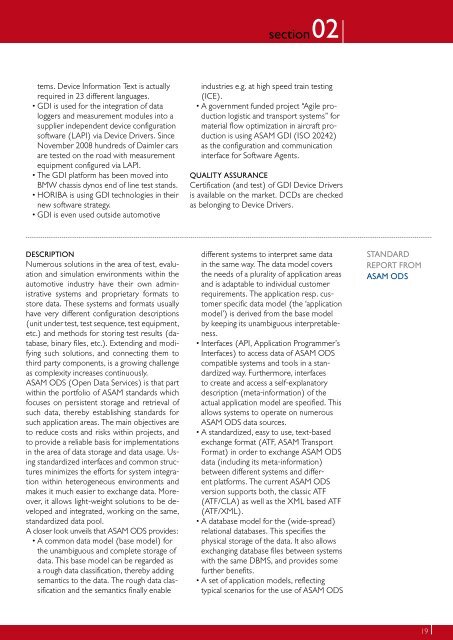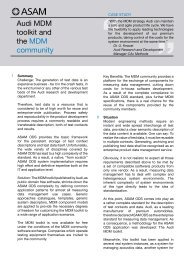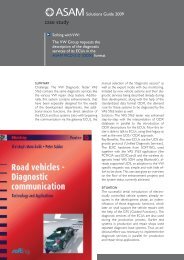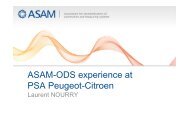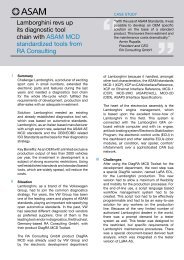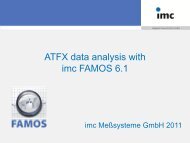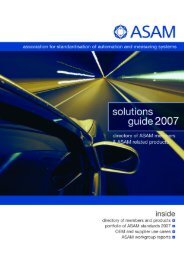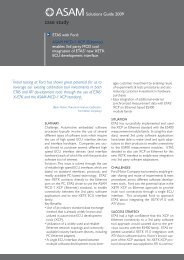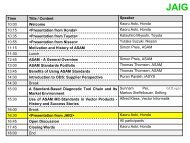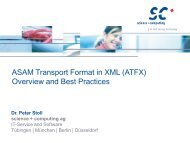Download now - ASAM
Download now - ASAM
Download now - ASAM
- TAGS
- download
- asam
- www.asam.net
You also want an ePaper? Increase the reach of your titles
YUMPU automatically turns print PDFs into web optimized ePapers that Google loves.
tems Device Information Text is actually<br />
required in 23 different languages<br />
• GDI is used for the integration of data<br />
loggers and measurement modules into a<br />
supplier independent device configuration<br />
software (LAPI) via Device Drivers Since<br />
November 2008 hundreds of Daimler cars<br />
are tested on the road with measurement<br />
equipment configured via LAPI<br />
• The GDI platform has been moved into<br />
BMW chassis dynos end of line test stands<br />
• HORIBA is using GDI technologies in their<br />
new software strategy<br />
• GDI is even used outside automotive<br />
DESCRIPTIOn<br />
Numerous solutions in the area of test, evaluation<br />
and simulation environments within the<br />
automotive industry have their own administrative<br />
systems and proprietary formats to<br />
store data These systems and formats usually<br />
have very different configuration descriptions<br />
(unit under test, test sequence, test equipment,<br />
etc ) and methods for storing test results (database,<br />
binary files, etc ) Extending and modifying<br />
such solutions, and connecting them to<br />
third party components, is a growing challenge<br />
as complexity increases continuously<br />
<strong>ASAM</strong> ODS (Open Data Services) is that part<br />
within the portfolio of <strong>ASAM</strong> standards which<br />
focuses on persistent storage and retrieval of<br />
such data, thereby establishing standards for<br />
such application areas The main objectives are<br />
to reduce costs and risks within projects, and<br />
to provide a reliable basis for implementations<br />
in the area of data storage and data usage Using<br />
standardized interfaces and common structures<br />
minimizes the efforts for system integration<br />
within heterogeneous environments and<br />
makes it much easier to exchange data Moreover,<br />
it allows light-weight solutions to be developed<br />
and integrated, working on the same,<br />
standardized data pool<br />
A closer look unveils that <strong>ASAM</strong> ODS provides:<br />
• A common data model (base model) for<br />
the unambiguous and complete storage of<br />
data This base model can be regarded as<br />
a rough data classification, thereby adding<br />
semantics to the data The rough data classification<br />
and the semantics finally enable<br />
02 section<br />
industries e g at high speed train testing<br />
(ICE)<br />
• A government funded project “Agile production<br />
logistic and transport systems” for<br />
material flow optimization in aircraft production<br />
is using <strong>ASAM</strong> GDI (ISO 20242)<br />
as the configuration and communication<br />
interface for Software Agents<br />
QuALITy ASSuRAnCE<br />
Certification (and test) of GDI Device Drivers<br />
is available on the market DCDs are checked<br />
as belonging to Device Drivers<br />
different systems to interpret same data<br />
in the same way The data model covers<br />
the needs of a plurality of application areas<br />
and is adaptable to individual customer<br />
requirements The application resp customer<br />
specific data model (the ‘application<br />
model’) is derived from the base model<br />
by keeping its unambiguous interpretableness<br />
• Interfaces (API, Application Programmer’s<br />
Interfaces) to access data of <strong>ASAM</strong> ODS<br />
compatible systems and tools in a standardized<br />
way Furthermore, interfaces<br />
to create and access a self-explanatory<br />
description (meta-information) of the<br />
actual application model are specified This<br />
allows systems to operate on numerous<br />
<strong>ASAM</strong> ODS data sources<br />
• A standardized, easy to use, text-based<br />
exchange format (ATF, <strong>ASAM</strong> Transport<br />
Format) in order to exchange <strong>ASAM</strong> ODS<br />
data (including its meta-information)<br />
between different systems and different<br />
platforms The current <strong>ASAM</strong> ODS<br />
version supports both, the classic ATF<br />
(ATF/CLA) as well as the XML based ATF<br />
(ATF/XML)<br />
• A database model for the (wide-spread)<br />
relational databases This specifies the<br />
physical storage of the data It also allows<br />
exchanging database files between systems<br />
with the same DBMS, and provides some<br />
further benefits<br />
• A set of application models, reflecting<br />
typical scenarios for the use of <strong>ASAM</strong> ODS<br />
STAnDARD<br />
REPORT fROM<br />
<strong>ASAM</strong> ODS<br />
19


